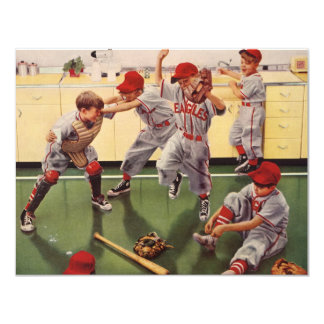
The end of the school year once meant something to boys. When textbooks were returned and summer vacation began, it was time for baseball.
There was never much of a fee to play and many spent their summers on the baseball field – competing against kids from their own area. It was the model that Washington Youth Baseball was built upon.
The league offered solace for boys looking to learn the game and keep active during the summer. Now, youth baseball has become a business and a lucrative one.
AAU leagues and travel organizations continue to increase in popularity across the country as players search for better training, competition and a chance to one day earn a collegiate scholarship. As a result, fewer kids are playing baseball, particularly at the recreation level.
According to the National Sporting Goods Association, a trade publication, the number of kids from ages 7-to-17 playing the sport in the country dropped from 8.8 million to 5.3 million from 2000 to 2013.
Several other studies found a similar trend, but Washington Youth Baseball president Rick Hernnberger said the organization has not been affected.
Though he could not provide participation numbers, Hernnberger said that the organization’s seven age divisions experienced growth in 2015. But Washington Pony had only four teams - down from six in 2013.
Its biggest competition seems to be travel baseball.
“You have to look at the parents’ view,” Hernnberger explained. “AAU provides more playing time for their kids and sometimes better competition. From our side and from what I’ve seen, a lot of the AAU isn’t better than rec ball and if is, it isn’t much better.”
Ed Skovron, the national baseball chair for the Amateur Athletic Union, said that the organization has grown an estimated 25-30 percent in the past five years. As numbers dwindle at local youth leagues, parents open their wallets to pay hefty fees for their children to compete on teams that travel across the country.
“The quality of our membership is one of the things that drives kids toward AAU,” Skovron said. “Parents and the player are looking for the best instruction. These coaches are usually former collegiate players or pro players, and they teach these kids the art of baseball. They get more training with AAU.”
That training comes with a hefty price tag. Though a membership with AAU costs just $14, joining a travel team can cost up to $2,000 or more per season, which does not include travel expenses. Some organizations in Western Pennsylvania travel every weekend to tournaments as far away as Florida.
Mark Saghy, who coached Mt. Lebanon High School to a PIAA championship in 1998 and is a co-founder of the Western Pennsylvania Elite Baseball League, has been told by some parents that they pay as much as $10,000 per summer for their child to compete on an AAU team.
That fueled him to help create the WPEBL 10 years ago. The league, which has AAU concepts and is strictly for high school students, does not travel to tournaments as frequently and has lower entry fees for its players. Like AAU, WPEBL’s goal is to still get athletes exposure to college coaches.
“I think AAU is built on false promises. These groups are telling kids and their parents that if you come play with us, we’ll travel all over and you’ll be amazed with how many scholarship offers you get,” Saghy said. “I give recruitment seminars and the first thing I tell them is it doesn’t make a bit of a difference who you play for.
“You can play for your local legion or Palomino team, or you can play for a team that travels across the country. The coaches will come and see you play if they believe you have the ability.”

Most teenagers and their parents are encouraged to join AAU organizations with the promise of earning an athletic scholarship, but NCAA Division I programs are only allotted 11.7 scholarships to fill 30 to 40 roster spots. Division II schools can offer nine scholarships, while Division III programs have none at all.
There are 300 NCAA Division I schools that offer baseball, while there are 264 in Division II. And many of those schools don’t offer their full compliment of scholarships for baseball.
On top of paying to join the team, players also are encouraged to seek professional instruction for hitting, pitching or other aspects of their game. Many baseball schools market themselves by how many former students were drafted or played in college and charge as much as $50 for a 30-minute lesson.
Between the price for a travel team and individual instruction, kids are often discouraged to continue playing a game that used to be seen as one of the cheapest.
It has trickled down to the youth level. Robert Swope – administrator for Little League District 9, which covers much of Washington, Greene, Fayette and Westmoreland counties – attributes low participation in the eight leagues he supervises to several factors.
Travel baseball and kids deciding to specialize sit atop the list, plus more options are available, such as lacrosse – one of the fastest growing sports in the country.
“Our numbers are down in almost every league,” Swope said. “We have soccer we’re competing against and travel teams. Everyone thinks their kid should be an all-star or that they’re the best in the area. It’s a combination, plus you have video games and TV. Today’s kids have too much that pulls them away from little league baseball.”
It’s a trend that concerns Saghy. Not only are parents and kids walking away from local rec programs, but they are entrusting their futures and money in AAU coaches or organizations. Some groups advertise playing in front of college scouts every weekend and facing top competition, but Saghy believes some coaches do not always deliver on that promise.
“The delusion of talent comes from a simple fact: it’s a business and people can make money,” Saghy said. “It’s a huge money maker. I have no problem with people who do it, but I think the problem is everybody in this day and time thinks as long as I pay my money I’m going to get what I want. It doesn’t work that way with baseball.
“If you pay me $2,000 or $3,000 a summer, I’ll tell you whatever the hell you want to hear so you come back next year, and I truly believe that. That’s where we have the biggest dilemma.”
Skovron, who oversees AAU’s governing body, did not offer any solution to AAU coaches or organizations taking advantage of the big business of baseball. Instead, he passed the responsibility down to the local level.
“Whether it’s an AAU program or a Cal Ripken program, that’s evident in every place,” Skovron said. “It’s just a matter of how the district and the people running that district can combat that. That’s a real hard thing to rectify, to be perfectly honest with you.”
With no solution in sight and AAU continuing to grow, youth baseball numbers at the recreation level will likely continue to drop.
Major League Baseball and the players’ union announced this week that it would commit $30 million to youth baseball development with an emphasis on engaging minorities – one of many groups that has sought alternatives as baseball has outpriced families across the country.
“Kids growing up start to believe early on that they can’t achieve the same in baseball that they can in another sport like basketball because they can’t afford to do it,” Saghy said. “It’s almost like the old philosophy when I was growing up that you couldn’t be a great golfer or tennis player unless you belonged to a country club.
“A lot of people are starting to look at baseball that way. I don’t think that’s true, but that’s the perception.”
Source: http://www.observer-reporter.com/article/20150705/SPORTS/150709683

 The end of the school year once meant something to boys. When textbooks were returned and summer vacation began, it was time for baseball.
The end of the school year once meant something to boys. When textbooks were returned and summer vacation began, it was time for baseball.